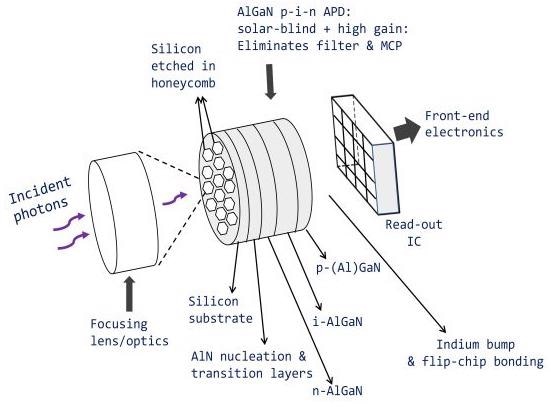Several devices and detectors detect and categorize deep UV frequencies that would otherwise be absorbed by the Earth’s ozone layer. The majority of solar-blind space-borne imaging systems still use photomultiplier tubes and/or micro-channels plates with silicon photodiodes, which adds to the complexity and weight of the devices.
 A possible schematic of deep-UV imaging assembly based on AlGaN photodetector, which can significantly cut down on weight, footprint, and complexities. Image Credit: Digbijoy N. Nath.
A possible schematic of deep-UV imaging assembly based on AlGaN photodetector, which can significantly cut down on weight, footprint, and complexities. Image Credit: Digbijoy N. Nath.
Researchers in India are asking why ultrawide bandgap (UWBG) photodetectors with deep UV capabilities have not seen widespread adoption after decades of development and promising results in the Journal of Applied Physics, published by AIP Publishing, and are taking stock of advancements and difficulties in the field.
From the device and materials point of view, enough advances have been made. Now, it is time to bring systems and imaging experts and device and materials engineers together to study and qualify UWBG detectors under actual conditions for real-world applications.
Digbijoy Nath, Study Author, Centre For Nano Science and Engineering, Indian Institute of Science
UWBG photodetectors made out of aluminum gallium nitride and gallium (III) oxide are more effective than silicon-based equivalents, can customize cutoff wavelengths, and do not require optical filters to eliminate visible or infrared wavelengths for solar-blind applications.
The capacity to scan with UV is crucial for industrial and biological uses, as well as strategic and astronomical interests.
In addition to assessing how durable and dependable devices are in real-world applications, the researchers said more work is needed to enhance how the materials are constructed over broad area substrates in a technique known as epitaxy, which involves depositing crystalline minerals onto a thin film.
Nath believes that a better understanding of the nanoscale can demonstrate how these devices can attain improved performance by improving the arrangement of atoms in the semiconductor lattice.
The researchers propose new criteria for evaluating photodetectors by taking gain, noise and bandwidth into consideration rather than the often referenced photo-to-dark current ratio, transient responses, responsivity and other factors.
Further improvement in these device performance parameters isn’t going to help mature this technology for real-world applications. It’s high time now for the community to have a pull from the industry and strategic sector so that device and material engineers can start working with imaging and systems groups to actually develop focal plane arrays and to integrate these with front-end electronics for real-life testing and applications.
Digbijoy Nath, Study Author, Centre For Nano Science and Engineering, Indian Institute of Science
Journal Reference:
Kalra, A., et al. (2022) The road ahead for ultrawide bandgap solar-blind UV photodetectors. Journal of Applied Physics. doi.org/10.1063/5.0082348.